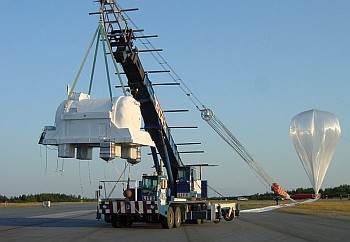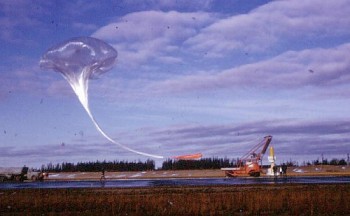
Founded in 1950, Lynn Lake is a tiny mining community located at 1070 km NW of Winnipeg, Manitoba, Canada. Its name comes from Lynn Smith who was chief engineer of the Sherritt Gordon Mines Ltd. company that discovered the first gold and nickel deposits in the region. It has a stable population of between 800 and 1000 inhabitants
The first stratospheric balloon launches were carried out in the 60's, when the local airport was used in a complementary manner during the annual sounding rocket campaigns of the Office of Naval Research (ONR) that were launched at Fort Churchill, although these were very sporadic. It was not until the early 90's when the first regular balloon launch campaigns were held from there. The site was chosen by the National Scientific Balloon Facility (NSBF) -which until the end of the previous decade made similar launches for the NASA balloon program from Prince Albert in Saskatchewan. The move to Lynn Lake was to enable longer duration flights from a more northerly location. A down range telemetry station was positioned at Ft. McMurray. Being a northern site it possessed a special attraction for those scientists who study cosmic rays. As is well known at high latitudes these rays are much less attenuated by the Earth's magnetic field. In addition, the low population density of the region made it ideal for test flights of new technologies or missions involving extremely heavy loads as was the case of the complex instruments that were developed during the last decade of the past century for cosmic radiation studies and the detection of very rare cosmic particles. Thus, several universities in the U.S., Japan and Germany developed over several years observing programs in Lynn Lake.

The site had the minimum infrastructure needed. A hangar at the airport become the building for the assembly of the gondola instruments. To hold the payloads at launch a plan was researched to move the launch vehicle from Fort Sumner but finally was discarded using instead a specially fitted crane. All the equipment necessary for tracking and recovery of scientific experiments was transported by truck from the United States on each campaign. The flights took place between July and August, during which Lynn Lake had the highest scientist per capita ratio in all Canada. Prevailing stratospheric winds in the area at that time of year, pushed the huge balloons westward, reaching the neighboring province of Alberta, where the flight was terminated in the Peace River area of Alberta.
In the late 90's closure of several mines (main engine of the local economy) heavily-affected the industrial and commercial activity of the town, so the activities carried out there by NASA initially helped to alleviate this situation. But, despite the fact that NASA had invested nearly $ 366,000 to expand operational capabilities of the airport, the lack of hotel infrastructure and services greatly hindered the development of campaigns and eventually contributed to the abandonment of the site as a launch base by the agency. However, the abandonment was preceded by a memorable event when the last balloon successfully launched from there in 2002 -nicknamed the "BIG 60" with a volume of two million cubic meters- managed to break the biggest balloon in flight record which remained unbeaten since 1975.
Table of balloons launched from Lynn Lake Airport
| Date | Hour | Flight Duration | Experiment | Payload landing place or cause of the failure |
|---|---|---|---|---|
| 9/27/1967 | 14:31 utc | 8 h | FAST NEUTRON DETECTOR | --- No Data --- |
| 8/21/1968 | 00:11 utc | 21 h | FAST NEUTRON DETECTOR | --- No Data --- |
| 9/12/1968 | 18:32 utc | 22 h | FAST NEUTRON DETECTOR | --- No Data --- |
| 9/26/1968 | 21:04 utc | 25 h | FAST NEUTRON DETECTOR | --- No Data --- |
| 9/29/1968 | --- | FAST NEUTRON DETECTOR | Operations failure | |
| 9/29/1968 | --- | FAST NEUTRON DETECTOR | Operations failure | |
| 9/30/1968 | 18:41 utc | 12 h 30 m | FAST NEUTRON DETECTOR | --- No Data --- |
| 8/9/1990 | 12:27 utc | --- | ALICE (A Large Isotopic Composition Experiment) | 35 miles SE of High Level, Alberta, Canada |
| 8/26/1990 | 11:39 utc | --- | MAGNETIC SPECTROMETER | 28 miles SE of Leaf Rapids, Manitoba, Canada |
| 7/25/1991 | 2:17 utc | 22 h | SMILI 2 (Superconducting Magnet Instrument for Light Isotopes) | 75 miles N of Peace River, Alberta, Canada |
| 8/9/1991 | 2:07 utc | 22 h | SOFIE (Scintillating Optical Fiber Isotope Experiment) | 75 miles N of Peace River, Alberta, Canada |
| 7/16/1992 | 20:35 local time | 23 h | IMAX (Isotope Matter-Antimatter Experiment) | Grimshaw, Alberta, Canada |
| 8/2/1992 | 00:52 utc | --- | COSMIC RAY ASTROPHYSICS | 11 miles N of Pukatawagan, Manitoba, Canada |
| 8/25/1992 | 13:21 utc | --- | LEE (Low Energy Electrons) | 28 miles NE of Moak Lake, Manitoba, Canada |
| 9/6/1992 | 14:00 utc | --- | LDBV (Long Duration Balloon Vehicle) - Flight Test # 3 | 57 miles NE of Thompson, Manitoba, Canada |
| 7/26/1993 | 00:17 utc | 17 h | BESS (Balloon-borne Experiment with a Superconducting Spectrometer) | 50 Miles S of High Level, Alberta, Canada |
| 8/13/1993 | 14:06 utc | 11 h | THISTLE (Tracking Heavy Isotope Spectrometer Telescope for Low Energy) | 5 miles W of Collins Bay, Saskatchewan, Canada |
| 8/17/1993 | 14:28 utc | 50 h | LDBV (Long Duration Balloon Vehicle) - Flight Test # 4 | 22 miles NE of Slave Lake, Alberta, Canada |
| 9/2/1993 | 14:16 utc | 5 h | TDRSS SYSTEM TEST | Balloon leaker. Payload landed 7 miles NW of Nelson House, Manitoba, Canada |
| 8/1/1994 | 2:30 utc | --- | BESS (Balloon-borne Experiment with a Superconducting Spectrometer) | 45 miles NW of Slave Lake, Alberta, Canada |
| 8/8/1994 | 12:26 utc | 23 h | CAPRICE (Cosmic AntiParticle Ring Imaging Cherenkov) | 150 km N of Peace River, Alberta, Canada |
| 8/17/1994 | 11:49 utc | 76 h | LDBV (Long Duration Balloon Vehicle) + TIC (Thin Ionization Calorimeter) | 13 miles NW of Fort McMurray, Alberta, Canada |
| 8/28/1994 | 1:13 utc | --- | AESOP (Anti-Electron Sub Orbital Payload) + LEE (Low Energy Electrons) | 49 miles NE of Laronge, Saskatchewan, Canada |
| 7/26/1995 | 2:04 utc | 12 h | BESS (Balloon-borne Experiment with a Superconducting Spectrometer) | 65 miles NNW of Slave Lake, Alberta, Canada |
| 8/23/1995 | 12:41 utc | F 32 h | HEAT (High-Energy Antimatter Telescope) | 3 miles N of Tadoule Lake, Manitoba, Canada |
| 8/26/1995 | 11:52 utc | ~ 4 h | COSMIC RAY EXPERIMENT | 8 miles NE of Slave Lake, Alberta, Canada |
| 7/23/1996 | --- | MKIV INTERFEROMETER | Aborted flight | |
| 7/24/1996 | 23:11 utc | 2 h 10 m | MKIV INTERFEROMETER | Balloon burst 15 miles SE of Lynn Lake, Manitoba, Canada |
| 8/9/1996 | 1:23 utc | 6 h | SOLAR PHYSICS | Balloon failure 10 miles E of Leaf Rapids, Manitoba, Canada |
| 8/20/1996 | --- | INFRARED ASTRONOMY | Aborted flight | |
| 7/28/1997 | 3:29 utc | 26 h | BESS (Balloon-borne Experiment with a Superconducting Spectrometer) | 5 miles NW of Dixonville, Alberta, Canadá |
| 9/2/1997 | 0:51 utc | 21 h 20 m | AESOP (Anti-Electron Sub Orbital Payload) + LEE (Low Energy Electrons) | 17 miles NW of Hudson bay, Canada |
| 7/30/1998 | 3:07 utc | 22 h | BESS (Balloon-borne Experiment with a Superconducting Spectrometer) | 8 miles SE of Peace River, Alberta, Canada |
| 8/4/1998 | 11:58 utc | 33 h | ISOMAX (Isotope Magnet Experiment). | 5 miles S of Deadewood, Alberta, Canada |
| 8/30/1998 | 2:17 utc | --- | AESOP (Anti-Electron Sub Orbital Payload) + LEE (Low Energy Electrons) | 4 miles N of Cross Lake, Manitoba, Canada |
| 8/1/1999 | 13:21 utc | ~ 2 hr | BESS (Balloon-borne Experiment with a Superconducting Spectrometer) | Reindeer Lake, Saskatchewan, Canadá |
| 8/11/1999 | 13:22 utc | 38 h 22 m (34.8 hr) | BESS (Balloon-borne Experiment with a Superconducting Spectrometer) | 22 miles NE of Hotchkiss, Alberta, Canada |
| 8/17/1999 | 00:01 utc | 45 h 13 m (42 h) | AESOP (Anti-Electron Sub Orbital Payload) + LEE (Low Energy Electrons) | 16 miles ENE of Peace River, Alberta, Canada |
| 8/10/2000 | 13:26 utc | 47 h 23 m | BESS (Balloon-borne Experiment with a Superconducting Spectrometer) | 31 miles SE of High Prairie, Alberta, Canada |
| 8/25/2000 | 23:49 utc | 24 h 18 m | AESOP (Anti-Electron Sub Orbital Payload) + LEE (Low Energy Electrons) | --- No Data --- |
| 9/1/2000 | 00:03 utc | --- | ISOMAX (Isotope Magnet Experiment). | Payload crashed near South Indian Lake, Alberta, Canada |
| 8/7/2002 | 1:58 utc | 23 h 14 m | BESS (Balloon-borne Experiment with a Superconducting Spectrometer) | 18 miles W of Ft. McMurray, Alberta, Canada |
| 8/13/2002 | 0:46 utc | 38 h 40 m | AESOP (Anti-Electron Sub Orbital Payload) + LEE (Low Energy Electrons) | 21 miles SW of Peace River, Alberta, Canada |
| 8/25/2002 | 1:05 utc | 22 h 15 m | LEE (Low Energy Electrons) + UHAB (Ultra High Altitude Balloon) test | 8 miles SSW of Anzac, Alberta, Canada |
If you consider this website interesting or useful, you can help me to keep it up and running with a small donation to cover the operational costs. Just the equivalent of the price of a cup of coffee helps a lot.

